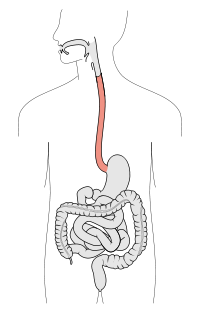
Photo from wikipedia
BACKGROUND Anorectal malformations (ARMs) are common congenital malformations of the terminal digestive tract, but little is known regarding their pathogenesis. Aberrant cell proliferation/apoptosis are believed to be involved in ARMs.… Click to show full abstract
BACKGROUND Anorectal malformations (ARMs) are common congenital malformations of the terminal digestive tract, but little is known regarding their pathogenesis. Aberrant cell proliferation/apoptosis are believed to be involved in ARMs. However, there are no studies on proliferation/apoptosis-related genes. PURPOSE We aimed to investigate the spatiotemporal expression patterns of two proliferation/apoptosis-related genes (MYC proto-oncogene and tumor protein p53) and explore their potential functions in the hindguts of ethylene thiourea-induced ARMs rat fetuses. METHODS MYC and p53 expression was evaluated using immunohistochemical staining, western blotting, and quantitative real-time polymerase chain reaction (RT-qPCR). Terminal deoxynucleotidyl transferase mediated dUTP nick end labeling (TUNEL) and p53 costaining were performed to assay the colocalization of apoptotic and p53-expressing cells. RESULTS Rat fetuses with ARMs displayed fusion failure of the urogenital septum and cloacal membrane. In the control group, MYC was persistently expressed from gestational day (GD)14 to GD16 and distributed throughout the hindgut, while p53 was weakly detected in the terminal segment of the urethra and hindgut; in the ARMs group, MYC expression was obviously reduced, while p53 was widely and highly expressed in the urethra and hindgut. Western blotting and RT-qPCR confirmed the decrease in MYC and increase in p53 expression in ARMs. TUNEL and p53 co-staining revealed considerable overlap between apoptotic and p53-expressing cells. CONCLUSION The expression patterns of c-myc and p53 were disrupted in ARMs rat embryos, and the downregulation of c-myc and upregulation of p53 might be related to the development of ARMs at the key time points of ARMs morphogenesis.
Journal Title: Acta histochemica
Year Published: 2019
Link to full text (if available)
Share on Social Media: Sign Up to like & get
recommendations!